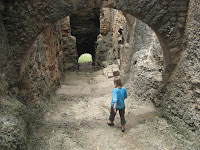On Wednesday of my first week at the hospital and the lab in Msambweni, I had my first opportunity to spend some time in the “theatre”, more mundanely known in the US as the OR (operating room). I was told the previous day that I would meet with Dr. Mwouri, the surgeon, at 9 AM, before they started operating. First of all, I would like to ask that the US adopt these surgery hours; medical students and residents in the US routinely arrive at the hospital at 5 am to prepare for the day’s surgeries. I digress. Mr. Katana, a man helping with some of the research, grabbed me from the lab to take me to meet the doctor. He said, “we will wait over here, where Dr. Mwouri parks in the morning”. Stalking physicians in the US is generally frowned upon, but what do I know about Kenya? We finally met the good doctor, and he welcomed me and invited me into his theatre. I was not sure what to expect, but suspected that it was going to be quite different from what I was used to.
Disclaimer: Though many people asked me before I left if I’d be doing the surgeries in Kenya, the country actually has very strict laws regarding practicing medicine in the country. Even the physicians from my school who come over here can’t practice in the hospital, as they’re not licensed in Kenya. So, this is strictly an observership.
I entered the building and immediately came to a small wall, which separated the “outside” from the cleaner “inside”. I was then handed a pair of rubber clogs, and directed to the locker room, where I was to change. After rummaging through a few piles of folded, mismatched scrubs (surely all donated at various times), I found a set that fit satisfactorily, and then attempted to put on my clogs, which I estimate were a size 7. Only about 7 sizes off. I walked out of the locker room like a man playing dress-up with his wife’s heels. Some of the nurses at the front desk noticed my quandary, and another man was directed to take off his slip-on sandals and give them to me. I weakly protested, but he traded with me. After the game of musical shoes, I was ready for action.
A surgical nurse kindly gave me a tour of the facility. The first area he showed me was a small room littered with ancient anesthesia machines, a few rickety beds, and some odds and ends. I figured that it was a storage room. “This is the recovery room”. However, he explained to me that because they lacked such basics as pulse oxymeters and oxygen tanks for patients, the room was not useful to them, so patients just recovered in the hallway outside of the theatre. So it basically was a storage room.
Next, he took me to the storage rooms. These were not the gleaming, sterile, fully-stocked rooms that we’re used to in western hospitals, but rather a few wooden shelves with the very basics: Rolls of gauze, tape, sterile gloves, sutures, syringes, several instrument trays, Foley catheters, etc. They had most things that one would expect in a hospital, but those things that were not disposable were many decades older.
Finally, the theatre. Msambweni District Hospital has two operating theatres. They are white, large, high-ceilinged rooms with (thankfully) air conditioning. There was one older surgical light positioned in the middle of the room, an electronically-adjustable surgical table (older version, of course), a completely analog anesthesia machine (it had two chambers: one labeled “halothane”, the other, “ether”), and a few metal tables. The nurse informed me that they did not have an anesthesiologist, so they did all of their surgeries under spinal (inject some lidocaine into the spinal cord) or local (inject lidocaine into the nerves that innervate the area on which you’re operating) anesthesia. Because this was a “District” and not a “Regional” hospital, the nurse told me that they just did the “very basic” procedures; hernia repair, cesarean sections, appendectomies, etc. Upon hearing this, I was mildly disappointed, as I had seen all of these operations in the states, and inguinal hernia repairs simply aren’t all that titillating. Still, I was sure that the experience would be far different from in the states. I had no idea.
Here’s a list of operations that I saw: Inguinal hernia repair, sliding inguinal hernia repair, amputation of gangrenous middle finder secondary to leprosy, skin graft to cover a foot degloving injury, a varicose vein ligation procedure, patellar wire removal, femur fracture, straightening, and casting for a severely deformed lower limb secondary to rickets, and placement of IV in a child with cerebral malaria. By my count, in the states, these procedures would have been performed by general, orthopedic, plastic, and vascular surgeons. At this hospital, most of the procedures were done by a doctor (someone who had finished medical school and had no specialist training), and a nurse. The surgeon was called in a few times to help with procedures that the doctors had never seen before, but for the most part, the physicians who on most days run the rest of the hospital, performed the operations.
To be clear, these are not all basic procedures, and I was surprised by the skill and willingness of the doctors to perform the surgery. I asked one of the doctors the day after about it, and she said: “I really don’t like the theatre. However, we don’t have a choice. We start the cases, and when we get stuck, we call in the surgeon, who will tell us what to do. We learn very quickly that way. He is very brave in what he is willing to do.” On my first day in the theatre, I saw a few people working very hard with very little, and it was impressive and humbling.
More to come. Below is a photo of hospital grounds.






















